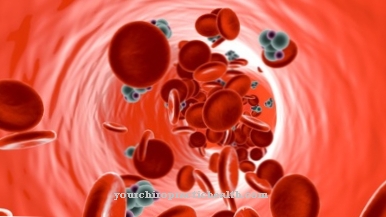The skin surface of all animal organisms, including humans, is covered with a Skin flora colonized by bacteria and fungi. The normal flora consists only of non-pathogenic microorganisms. As commensals or mutuals, many bacteria or fungi have a positive influence on the health of the skin.
What is the skin flora?

Every person has a skin flora made up of microorganisms on their skin surface. These are non-pathogenic bacteria or fungi that often play a major role in the health of the skin and the entire organism.
The normal flora of the skin also includes neutral microorganisms that feed on the substances on the skin's surface, but are otherwise of no further importance. Pathogenic microorganisms only have a chance if the immune system is weakened or if the surface conditions of the skin vary greatly.
The skin flora is divided into the resident and transient flora. While the resident skin flora describes the permanent colonization of certain microorganisms, the transient flora describes the colonization with temporary types of bacteria or fungi. Healthy skin also harbors opportunistic microorganisms that are normally not pathogenic. However, if the immune system is weakened or the skin is damaged, they can assume pathogenic properties.
The normal skin flora differs from person to person and depends on age, genetic predisposition, gender, skin area and environmental conditions.
Function & task
The skin flora is of great importance for the health of the skin and the entire organism. The normal colonization of the skin includes resident microorganisms, which, as commensals or mutuals, ensure that the body is protected from pathogens. The existing colonization of non-pathogenic bacteria or fungi prevents the penetration of pathogenic germs into the existing biotope.
Certain environmental conditions have developed that only benefit the existing skin flora. However, the different skin areas are also populated differently. Different microorganisms settle near sweat glands than on dry skin areas. In turn, sebum glands favor lipophilic fungal and bacterial species.
The pH of the skin is in the acidic pH range between 5.4 and 5.9. The acid mantle of the skin is referred to here. In this area, non-pathogenic microorganisms are favored. Studies have also shown that the growth of pathogenic species such as Propionibacterium acnes is inhibited under these conditions. At the same time, the pathogenic germs are in competition with the non-pathogenic microorganisms. The pathogenic germs cannot prevail under normal conditions.
The resident permanent settlers of the skin include staphylococcus (coagulase-negative), micrococcus or Corynebacterium. In contrast to Staphylococcus aureus, the coagulase-negative staphylococcus does not develop any coagulase. Coagulase is a protein complex that plays a major role in the pathogenesis of abscesses. Due to this fact, the coagulase-negative staphylococcus is not pathogenic. Micrococcus is also apathogenic and is part of normal human skin colonization. Corynebacteria are also found everywhere. Many of them are harmless and colonize the skin. The colonization of the skin with these bacteria reduces the chance of pathological germs.
Temporary transient microorganisms are, for example, types of bacteria such as Pseudomonas or Enterobacteria. Furthermore, fungi or viruses can temporarily settle on the skin. Under normal conditions these microorganisms do not pose a threat. However, there are also germs that are referred to as temporarily resident. Although they basically belong to the transient flora, they do not develop any symptoms for a long time. They only become pathogenic under special conditions. A classic example of this type is Staphylococcus aureus.
You can find your medication here
➔ Medicines for skin redness and eczemaIllnesses & ailments
If the balance of the skin flora is disturbed for any reason, it comes to the spread of pathogenic germs with different symptoms. Changes in the environment of the skin occur as soon as there is a change in the hormonal system during puberty. Boys in particular often suffer from acne during this time. One reason for this is the spread of the Propionibacterium acnes bacterium.
The bacterium Staphylococcus aureus often causes folliculitis. This is an inflammation of the outer part of a hair follicle. This disease occurs particularly on hairy areas and is promoted by frequent sweating. Under certain circumstances, an abscess can develop that must be surgically removed. Folliculitis can also be caused by the yeast Candida albicans. However, this is usually due to a serious immune-weakening disease.
Changing the pH to higher values damages the protective acid mantle of the skin. Various pathogenic microorganisms do not tolerate the normal acidic pH value of the skin and their growth is inhibited. In addition, some enzymes that are involved in building a skin barrier only work in this PH range. The elimination of this protective acid layer and the skin barrier is often the starting point for infectious skin diseases. Excessive skin hygiene through frequent hand washing and showering with alkaline soaps can destroy the protective acid mantle of the skin. In addition, the skin is also degreased and thus encourages the penetration of pathogenic germs.
Increased moisture in the skin due to increased perspiration sometimes promotes peptostreptococci, which may be the cause of sweat gland abscesses. This often affects the armpits, spaces between the toes, groin or the anal fold.
However, bacterial skin diseases or fungal diseases of the skin and mucous membranes can also be the result of serious underlying diseases. Non-infectious skin diseases such as eczema or psoriasis can also be the starting point for infectious skin diseases. Immune-weakening diseases such as diabetes, cancer or AIDS as well as therapies such as chemotherapy or antibiotic treatment can also destroy the normal skin flora.













.jpg)

.jpg)
.jpg)











.jpg)